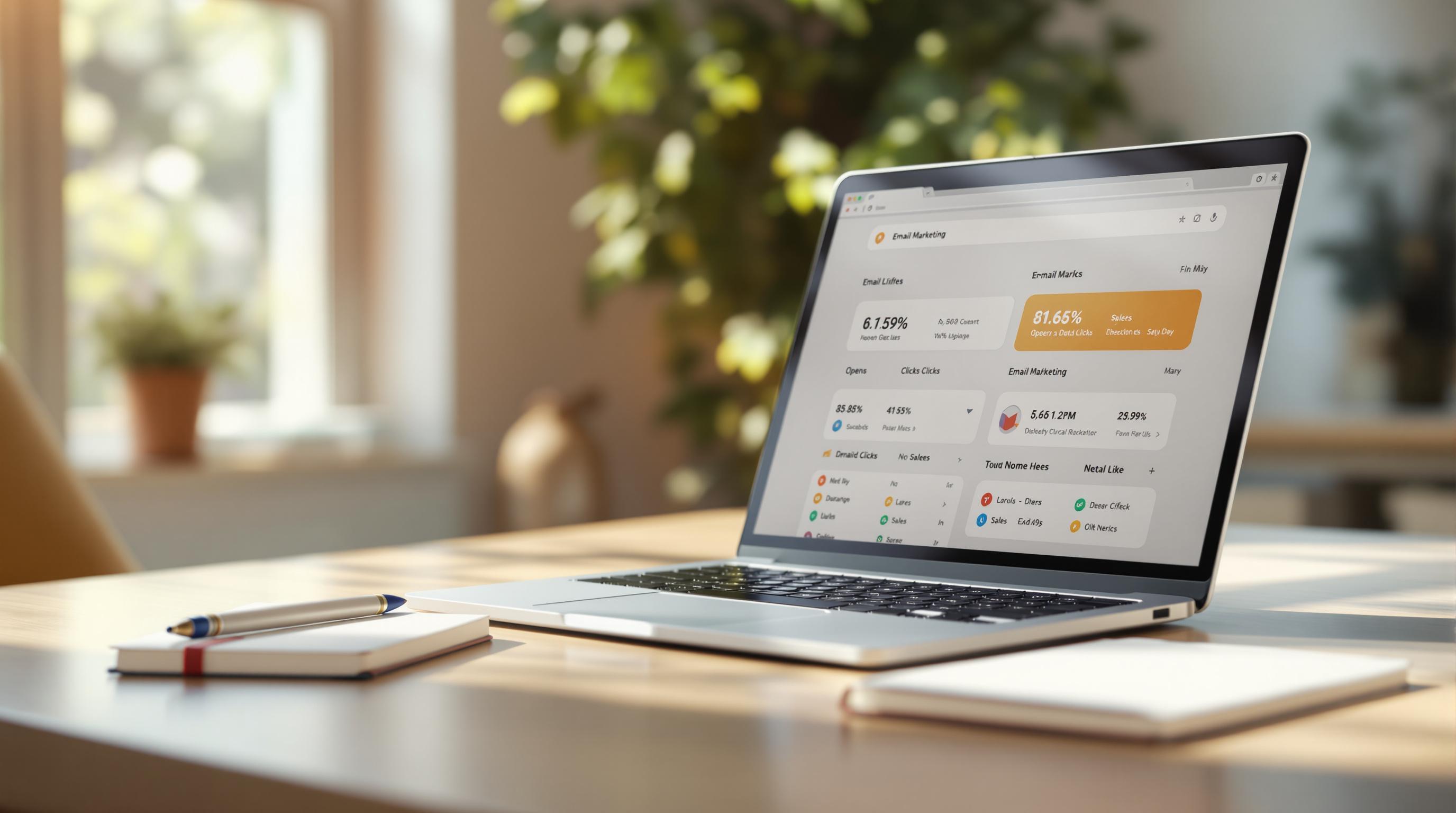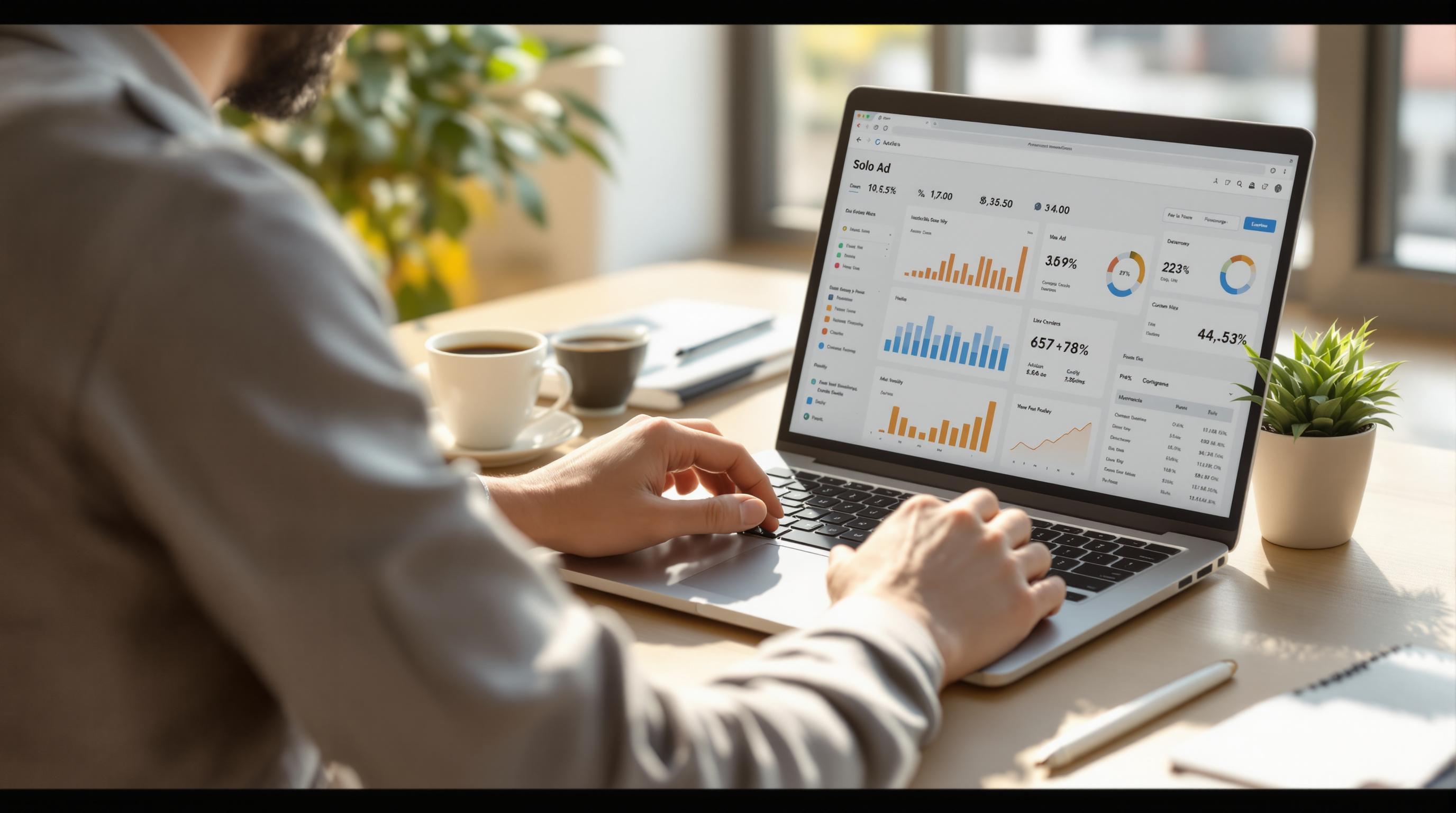Looking to build your email list? Solo ads and PPC are two popular methods with distinct advantages:
- Solo Ads: Ideal for niche markets, offering pre-qualified audiences and higher conversion rates (20-40%). Lower cost-per-lead (CPL) for industries like weight loss and affiliate marketing.
- PPC: Best for large-scale campaigns, delivering cold traffic with better long-term scalability and advanced targeting. Higher lead quality but at a higher cost.
Quick Comparison Table
| Feature | Solo Ads | PPC |
|---|---|---|
| Audience Type | Pre-qualified subscribers | Cold traffic |
| CPL (Cost Per Lead) | Lower ($0.75-$1.20) | Higher ($2.30-$5.00+) |
| Conversion Rates | 20-40% | 5-15% |
| Retention | 60-70% (90 days) | 40-55% |
| Best For | Niche markets, small budgets | Large-scale growth, remarketing |
Key Takeaway
- Use Solo Ads for quick results in niche markets or limited budgets.
- Go for PPC when you need scalability, long-term growth, and advanced targeting.
Both methods can work together for better results. Read on for a detailed breakdown of costs, engagement, and when to use each.
Solo ads vs PPC (3 Reasons Pay Per Click Wins)
What Solo Ads and PPC Are
Solo ads and PPC use completely different methods to build an email list, each with its own approach and structure.
Solo Ads Explained
Solo ads work by tapping into the connection between list owners and their subscribers. Marketers pay for email placements through platforms like Udimi, with costs ranging from $0.30 to $2 per click. Campaigns typically require a minimum investment of $100 to $500 [1][5]. This approach benefits from the pre-existing trust between the list owner and their audience, making it particularly effective in niche markets.
PPC Advertising Basics
PPC advertising takes another route, focusing on grabbing attention through search engines and social media. It uses keyword targeting and demographic data to reach people who may not yet know about your brand.
Running a PPC campaign involves several steps: conducting keyword research, writing compelling ad copy, and designing optimized landing pages. Since PPC reaches "cold" audiences, it demands constant fine-tuning to scale effectively, as shown in our CBD case study.
| Feature | Solo Ads | PPC |
|---|---|---|
| Audience Type | Pre-qualified subscribers | Cold traffic |
| Trust Factor | Uses existing relationships | Builds trust from scratch |
| Targeting Method | List owner's audience | Behavioral/Interest data |
These differences in how they function lead to noticeable variations in the return on investment for building email lists. Let's dive into the numbers to compare them more closely.
Measuring Solo Ads vs PPC Results
To compare solo ads and PPC effectively, you need to focus on the key metrics that drive email marketing success. Let’s break it down.
Cost and Return Analysis
The cost differences between solo ads and PPC campaigns can be striking, especially in competitive industries. PPC clicks often cost $1-$5+ each depending on the niche [2][9]. Here’s a quick look at how costs stack up:
| Industry | Solo Ads CPL | PPC CPL |
|---|---|---|
| Weight Loss | $1.20 | $4.80 |
| Affiliate Marketing | $0.75 | $2.30 |
These variations in cost per lead (CPL) directly influence how each method performs in terms of conversions and ROI.
Email Signup Rates
When it comes to email signups, solo ads tend to pull ahead. Thanks to their pre-qualified audiences, solo ads boast 20-40% conversion rates, which is much higher than the 5-15% typically seen with PPC campaigns [7][5].
For example, one eCommerce brand reported a 38% conversion rate from solo ads compared to just 12% through Facebook Ads [5]. This difference underscores the advantage of targeting warm audiences (solo ads) versus cold traffic (PPC).
Subscriber Quality Comparison
"PPC-generated leads often convert 2x faster than solo ad leads due to better intent alignment." - Digital Marketing Benchmarks Report 2024 [6]
Subscriber quality varies between the two approaches, with some clear trends:
Solo ad subscribers tend to show:
- 45-60% open rates
- 8-15% click-through rates
- 60-70% retention after 90 days (with proper list management) [5][7]
PPC subscribers, on the other hand, show:
- Lower initial engagement (25-35% open rates) but higher potential for remarketing through pixel tracking
- 40-55% retention, with strong opportunities for recovery via retargeting [9]
Solo ads often yield higher immediate engagement due to the trust built with their audience. However, PPC campaigns shine in long-term remarketing efforts, especially when leveraging data-driven strategies. Both methods require tailored approaches to nurture their unique subscriber bases effectively.
sbb-itb-aaea31d
Advantages and Drawbacks
These performance metrics help highlight the strengths and weaknesses of each method.
Solo Ads: Pros and Cons
Solo ads offer a fast way for email marketers to grow their lists. One of their biggest perks is instant access to pre-qualified audiences, making them a great option for businesses with smaller marketing budgets.
They're especially effective in specialized markets. For example, an eco-friendly startup targeting sustainability-focused email lists doubled its conversions, showing how well solo ads can perform in niche spaces [7].
But there are downsides. Since you don’t own the audience, you can’t retarget people who didn’t convert [2]. A case study from Warrior Forum revealed that this limitation led to 40% fewer repeat conversions compared to PPC campaigns that used retargeting [8].
While solo ads work well in specific niches, PPC shines in larger, more diverse campaigns.
PPC: Pros and Cons
PPC advertising offers advanced targeting and detailed campaign control. With PPC, you can fine-tune your audience and optimize campaigns based on data. According to the 2024 Email Marketing Benchmarks, 68% of marketers reported better lead quality from PPC compared to solo ads [6].
| Strength | Impact on Email Marketing |
|---|---|
| Better lead quality | 68% higher sales readiness [6] |
| Scalability | Reaches audiences 5x larger |
| Data-driven control | Optimizes the entire sales funnel |
However, PPC has its challenges. It can be expensive and requires technical expertise to manage complex campaigns effectively [4].
The choice depends on your budget and goals. Solo ads are great for quick, niche-focused results under $5k/month. Meanwhile, PPC requires a bigger investment but offers broader reach and scalability for larger campaigns [2].
When to Use Each Method
Solo Ads for Specific Markets
Solo ads work best for niche markets with highly engaged audiences. They shine in areas like health and wellness, where targeted email lists often outperform broader advertising methods.
For example, a keto diet coaching program saw conversion rates of 3.2% using health-focused email lists, compared to just 1.1% with Google Ads [7][2]. Similarly, a language learning platform cut its cost per acquisition (CPA) from $22 to $14 by targeting expat communities [7][9]. That’s a 36% cost reduction without sacrificing lead quality.
Here’s where solo ads are especially effective:
| Business Type | Key Metrics |
|---|---|
| Subscription Boxes | 25-35% lower CPA [2] |
| Coaching Services | 40-60% higher lead quality [5] |
| Affiliate Products | Leads generated within 24-48 hours [7] |
| Niche Info Products | Ideal for budgets under $2,000/month [3] |
PPC for Large-Scale Growth
PPC is a go-to for businesses aiming for large-scale growth. It’s particularly effective for companies that need advanced targeting and are prepared to invest in building long-term email lists.
Enterprise SaaS companies, for instance, report an 18% improvement in lifetime value for leads acquired through PPC, according to HubSpot [10][9]. This is largely due to PPC platforms offering robust retargeting and detailed demographic filters.
"Our data shows combining both methods yields 28% better retention than single-channel approaches, but PPC becomes essential when scaling beyond 10,000 monthly subscribers", highlights ConversionDNA's recent case study [9].
PPC is especially useful for:
- Industries with strict compliance needs (like crypto or healthcare)
- Mass-market products that require precise demographic targeting
- Campaigns focused on geographic or language-specific audiences
- Businesses with monthly budgets over $5,000 [2]
Although PPC often requires a 6-8 week optimization period, it provides the scalability needed for businesses looking to expand beyond their initial market [1][5].
Picking Service Providers
The success of your campaign largely depends on choosing the right providers after deciding on your primary method.
Finding Reliable Solo Ad Sellers
To get the best results, you need to evaluate list quality and engagement. Here’s what to look for:
| Element | What to Check | Warning Signs |
|---|---|---|
| List Demographics | Detailed age/location data | Purchased or merged lists [3] |
| Performance Metrics | 25%+ open rates | Unrealistic guarantees (>5%) [1] |
| Click Quality | Over 90 seconds on-page | Low engagement rates [5] |
Top-tier vendors often use tracking tools like ClickMagick [1][3]. Before committing to larger investments, start small with 50-100 click tests to measure cost-per-double-opt-in [8].
"Our data shows that successful solo ad campaigns start with micro-tests of 50-100 clicks, focusing on engagement metrics rather than immediate sales conversion", states a recent study by ConversionDNA [5].
Choosing PPC Networks
Different platforms cater to specific needs:
| Platform | Best Use Case | Average Conversion Rate |
|---|---|---|
| Google Ads | B2B/High-Intent | 7.2% [6] |
| Facebook Ads | Lifestyle Brands | 4.5% [6] |
| LinkedIn Ads | Executive Audiences | 3.1% [6] |
TikTok’s Spark Ads offer a cost advantage, delivering 40% lower CPLs compared to Instagram Reels ads. These are especially effective for youth-focused email campaigns [6].
To ensure your PPC campaigns run smoothly, make sure the platform supports:
- Tracking parameters
- CRM integrations
- Cross-device conversion monitoring [2][4]
A good rule of thumb is to allocate 70% of your budget to proven channels and 30% to testing new ones [1]. Also, check if platforms allow you to exclude current subscribers by uploading customer lists [6], helping you stay aligned with your campaign’s ROI goals.
Making Your Choice: Solo Ads or PPC
Deciding between solo ads and PPC comes down to three main factors: your budget, how quickly you need results, and the nature of your industry.
Here’s a quick comparison: SaaS companies often see lower costs per lead (CPL) with solo ads ($3.20) compared to PPC ($4.80). On the other hand, ecommerce brands tend to benefit more from PPC ($3.90 vs $5.10 CPL with solo ads) [2][9]. This ties back to subscriber quality - engagement rates within specific industries can significantly impact conversion costs.
When analyzing campaign performance, keep an eye on these key metrics:
- Lead quality scores above 8/10: A sign your solo ad campaigns are working well [5].
- CPL increases over 15% in three months: This might be a good time to experiment with PPC [9].
- Subscriber churn rates over 5%: Indicates it’s time to revisit your targeting strategy [2].
If speed is a priority, solo ads can generate quick results - SaaS companies, for example, have achieved 500 signups in just 48 hours [2]. PPC, while slower (typically taking 6-8 weeks), excels in building long-term, sustainable lists through remarketing [9]. The choice often boils down to whether you’re aiming for immediate growth or a more gradual, lasting impact.


